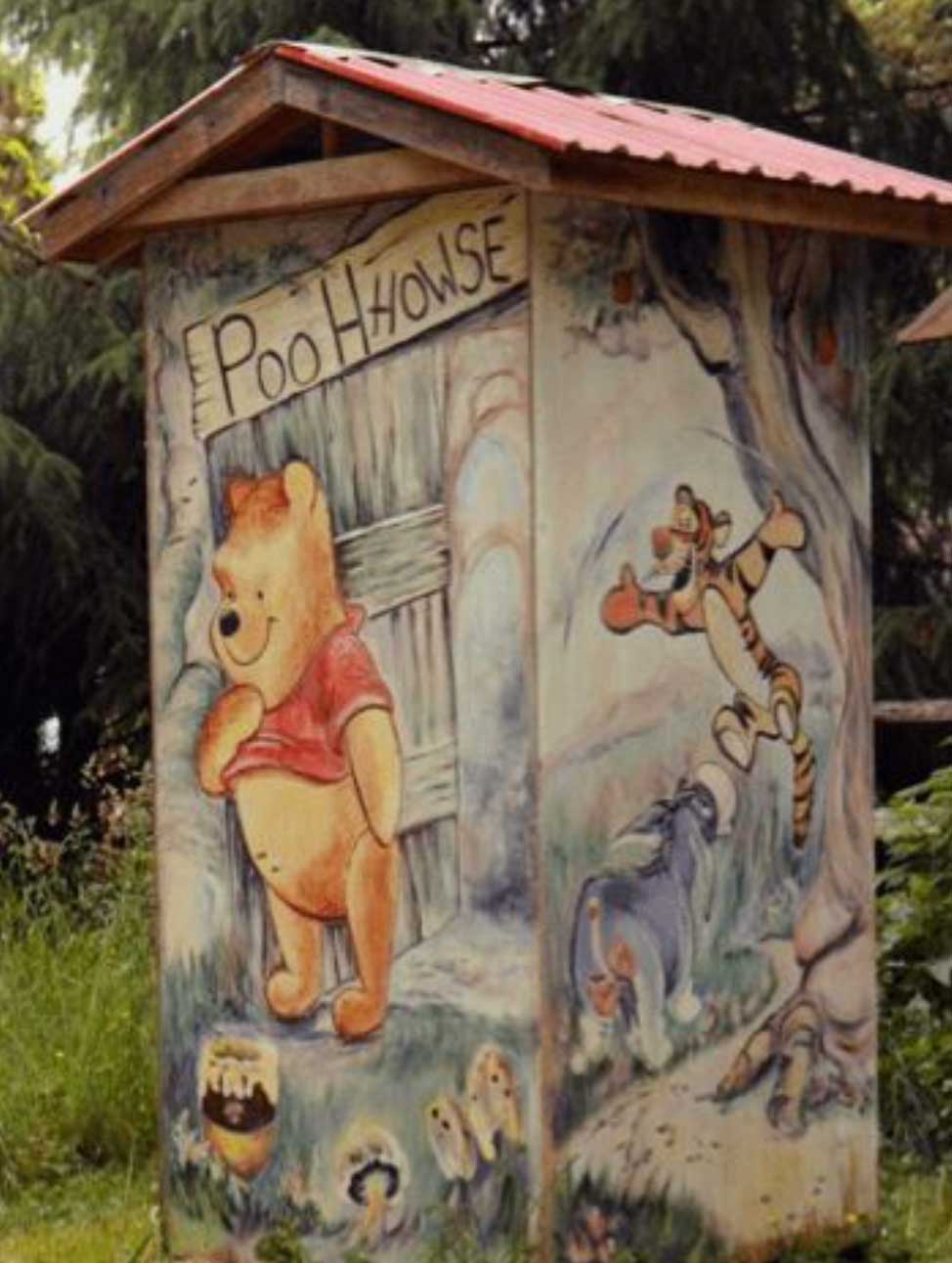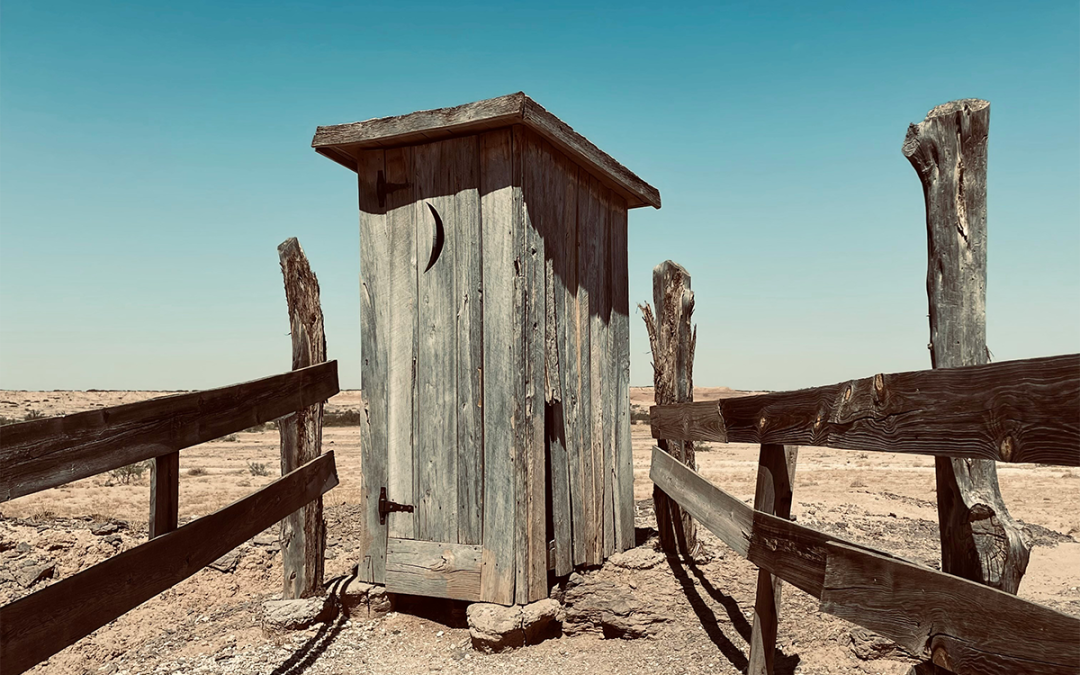Outhouses usually were located 50 to 100 yards from the back of one’s home. (Image courtesy of Daniel Coronoa / Unsplash.com)
June 2024
Cover Story
Privacy, please
Outhouses were a part of daily lives in centuries past
by Corbin Crable
We all take indoor plumbing for granted, and that includes in the bathroom. But before the advent of this technology, the outhouse gave us a place to “do our business,” as it were.
Toiletology.com, a blog that includes professional research, studies and reviews of toilets, also includes a history of outhouses, those small structures that include a hole in the floor that emptied into “a small tin or bucket that caught the waste; it had to be emptied daily by one lucky winner.”
A daily necessity
Outhouses – or “necessaries,’ as they were sometimes referred to — are only around 500 years old. Throughout their early history, they were found in both rural and urban areas. As urban areas’ populations increased and cities began to adopt indoor plumbing, however, outhouses posed a significant public health concern, and later in their history, they were mostly only found in the countryside.

Outhouses could be found not only here in America
Outhouses could be found not only here in America, but around the world, such as this outhouse in Belarus. (Image courtesy of Jana Shnipelson / Unsplash.com)
“Constructed of wood, they were easy to relocate if need be, and they were typically well built and painted for added durability,” according to Toiletology.com. “The interior hole in an outhouse was between three and six feet, and there might be more than one hole if the outhouse was catering to a family.”
If you’ve ever seen an outhouse, you might first notice either a moon- or a sun-shaped hole carved into the door. This wasn’t only included for decoration, Toiletology notes – the symbols denoted who could use the facility.
“This was common among American outhouses during the day and signified whether the structure was for men or women,” the blog reads. “A moon meant that it was a female-only outhouse, as the moon was a symbol of the Roman goddess Luna. The sun, which represented the Greek god Apollo, meant that it was a men’s outhouse.”
They went by many names besides ‘outhouse’ – privy, little house, back house, latrine, and water closet, just to name a few. Located roughly 50 to 100 yards away from the house, they were far enough away from one’s house that they afforded plenty of privacy, but close enough that one didn’t have to walk a great distance just to relieve himself or herself.
“Some owners camouflaged the structures with plantings of hollyhocks, trumpet vine, wisteria, and honeysuckle,” according to an article published in “Capper’s Farmer,” published by Topeka, KS-based Ogden Publications. “Sometimes the structures were placed near the family’s wood pile, so users, on their way back to the house, could pick up and carry in an armload of wood, so there would always be wood to feed the stove.”

The moon symbol carved into an outhouse door signaled it was for use by women
The moon symbol carved into an outhouse door signaled it was for use by women, while a cutout of the sun designated the outhouse for use by men. (Image courtesy of Patti Klinge)
Hand me the sports section, would ya?
What about cleanup when you were finished using the outhouse? Forget about toilet paper, writes the late historian Thomas Webb.
“Before the availability of mass-produced toilet paper during the mid-1800s, people had to resort to using what was free and available, even if it didn’t provide the most effective or comfortable results,” Webb wrote, “Options included the Sears and Roebuck catalog, rocks, leaves, newspapers, grass, moss, animal fur, corn cobs, coconut husks, sticks, sand, and sea shells.”
In many rural areas, indoor plumbing and indoor toilets were unavailable as late as the 1930s and 1940s. Outhouse users, however, had unlikely friends in President Franklin D. Roosevelt and First Lady Eleanor Roosevelt. President Roosevelt founded the Work Projects Administration, an entity whose purpose was to replace rural outhouses that had fallen into disrepair.
“With three workers and $5, the Administration could construct a new outhouse in 20 hours. These new and improved outhouses included proper ventilation, privacy, and flooring too,” according to Toiletology. “The Work Projects Administration successfully completed two million outhouses during its run. The First Lady’s commitment to the cause led to outhouses earning the nickname ‘The Eleanor’” (By the postwar period in America, the outhouse mostly fell out of use, replaced even in rural areas by indoor toilets).

President Franklin D. Roosevelt and First Lady Eleanor Roosevelt
President Franklin D. Roosevelt and First Lady Eleanor Roosevelt were known for their support of the renovation of outhouses throughout FDR’s 12 years in the White House. (Image courtesy of The March of Dimes)

Vintage Postcard
Although not everyone has fond memories of outhouses, there is sometimes humor to be found in them, such as this vintage postcard. (Image courtesy of Wikimedia)
Thank goodness for the gongfarmers
Speaking of unique names, the poor soul who had the unenviable task of emptying the outhouse bucket each day was referred to as a “gongfarmer.” Though they were well-paid, the job, as one could imagine, wasn’t just wholly unglamorous but also could be dangerous (one gongfarmer in the 14th century fell into an outhouse pit and drowned in human waste).
Although most outhouses were only one story tall, there have been a handful of two-story outhouses in existence. These were usually built to accommodate the two-story apartment buildings next to it. One of them was located in Illinois, according to Toiletology.
“The second-story apartments sat above a general store and the outhouse made it more convenient for employees and tenants to have access,” the blog reads. “The upstairs portion of the outhouse was built a little further back so that its contents didn’t spill into the bottom floor.”
Outhouse memories: Some good, but mostly bad
In a 2014 column published in Louisville, Kentucky’s The Courier-Journal, columnist David Strange wrote that despite their faults, outhouses hold a certain “rustic charm.”
“I remember birds singing as their feet tapped a dance on the sheet metal roof; occasional rain drops and falling acorns making their own drumbeat on that same roof; breezes gently blowing off the nearby cattle fields as the cows mooed their contented bass accompaniment off in the distance,” Strange wrote. “I even remember listening to the elder men tell fascinating stories as they stood outside, chatting with one another, waiting their turn or just enjoying the fellowship and the day.”
Still others who remember using outhouses share memories that clearly illustrate why they’re best remembered only as a necessity of a time gone by.
“For kids, the outhouse was horrific in the summer. Wasps infiltrated the outhouse every year, building honeycombed hotels seemingly overnight. The heat of the day made the outhouse even more aromatic than usual,” columnist Mary Garrison Leech wrote in The Canton Daily Ledger in 2022. “The walls of our outhouse were planks of tired wood, with splintery gaps here and there. Peeking eyes could watch us if they dared to brave the elements and atmosphere, but that usually wasn’t a problem. The mosquitos, however, had no qualms about sneaking through the cracks to pay us a toll call. Some of the worst itchy bites I ever had were in places I never thought a mosquito could find.”
Not everyone, however, would rather keep outhouses relegated to the past; indeed, conservation efforts exist by a few dedicated individuals, the most notable in Clarinda, Iowa, by Teresa Minard, a retired schoolteacher, fondly nicknamed “the Outhouse Lady” by the locals. Minard noted in a 2014 USA Today article that some historical organizations such as The Iowa Barn Foundation are interested in maintaining the few remaining outhouses in the interests of history.
But most of the people with whom she speaks don’t see outhouses as relics to be preserved.
“(People) like to reminisce,” Minard said, “but they don’t want to go back to that era.”
Toiletology’s blog article seems to agree – when it comes to outhouses, the pull of nostalgia is strong. “While society has moved on to more upscale portable toilets and public restrooms,” it reads, “there is something nostalgic about finding an outhouse out in the country.”

An old outhouse becomes new again
An old outhouse becomes new again with the addition of some paint and a few embellishments – perfect for glamping or an outdoor party. (Image courtesy of Pinterest)

The modern outhouse
The modern outhouse we find at most outdoor events. (Image courtesy of PortyPottyDogs)

“Outhouse on Wheels”
This “outhouse on wheels” from the 1930s was a precursor to the Porta-Potty. It was used for farm workers. (Image courtesy
of Pinterest)

Little creativity (and a mind for puns, too)
Not every outhouse has to be dull and drab. Sometimes all you need is a little creativity (and a mind for puns, too). (Image courtesy of Cottage Life)


